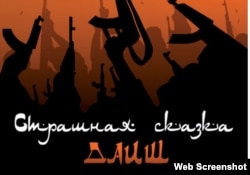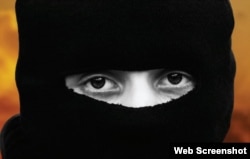A tree covered with the bloody dead bodies of more than a hundred villagers — women, children and elders. A dying young boy telling the story about merciless forces of darkness that came at night to slaughter the innocent. The remorseless rage of the inhumane warlord who ordered the genocidal act.
Fans of the 2006 Hollywood blockbuster “300" would say these horrifying images are from the movie’s famous tree-of-the-dead scene.
There is a distinct similarity, but they come from one of four “eyewitness” accounts contained in a new anti-Islamic State brochure that is being distributed in Russia’s public schools, colleges and universities as required reading.
The 38-page illustrated brochure, “Strashnaya Skazka Daesh” ("Daesh Horror Story"), says its aim is to “unmask IS recruitment strategies.” It was prepared by the Russian Peace Foundation, which is part of Russia’s Public Chamber, a government entity established to monitor the nation’s human rights.
In announcing that the brochure would be distributed among the country’s students, Yelena Sutormina, a Public Chamber official and co-author, said late last month that its aim was to inform teenagers about the methods of “various pseudo-religious and extremist organizations” so that they can “resist their recruiters.”
The brochure, Sutormina said, contains “real stories” of people who were able to escape the influence of recruiters.
The first-person accounts contained in the brochure, all of which are anonymous, describe alleged atrocities committed by American troops as being a major “motivating factor” for joining IS.
The Russian government frequently expresses concern about the threat to Russian security posed by IS-linked extremists. According to government data, more than 5,000 Russian citizens have joined IS and other jihadist groups in Iraq, Syria and Afghanistan. Some experts put the actual number at 7,000.
Alleged U.S. brutality
The tree-of-the-dead scene in the brochure depicts atrocities allegedly committed by U.S. troops in an unnamed village near Tikrit, Iraq. The anonymous narrator describes how the American troops’ brutality stuck in his mind, burning his soul with a desire for revenge and eventually pushing him to join IS. The man, self-described as an anthropologist, says he became an IS cameraman who filmed the executions committed by the infamous Jihadi John (Mohammed Emwazi), who, he says, was a drug addict hardly able to perform his duties, cutting the throats of the IS prisoners. One of the real Jihadi John’s victims was American reporter James Foley, who was beheaded in August 2014.
The cameraman’s story ends with him preparing to shoot himself in the head.
“Nothing even remotely like that has ever happened in U.S. military history,” Robert Schaefer, a member of the U.S. Army Special Forces (Green Berets) and a Eurasian Foreign Area Officer, said in an emailed response to VOA after studying the brochure. “We've had a few folks that have committed some atrocities. Every single one of them has faced trial.”
Perceived U.S. hostility
In a poll conducted last month by the Levada Center, an independent Russian polling agency, the United States topped the list of five countries that respondents said were the most unfriendly and hostile to Russia. Center director Lev Gudkov said the poll’s results showed the impact of what he called an extremely powerful and effective anti-American campaign being conducted by the Russian authorities.
Some experts say the anti-IS brochure is part of this campaign.
Stephen Blank of the American Foreign Policy Council said the brochure is clearly a propaganda narrative and is “at least as anti-Western as it is anti-ISIS."
“It does not actually make IS look like such a dangerous terrorist organization,” Blank told VOA. “I am not sure what effect it is going to have on people in persuading them not to join ISIS, but it certainly is tempting to link terrorism with the West.”
Grigory Shvedov, chief editor of the independent Russian news agency Caucasian Knot, said the accounts in the anti-IS brochure were deliberately aimed at spreading “hatred towards the West.” While some of the information in the brochure is accurate, he said, its narrative is unfortunate and does not help achieve its publicly stated goal of thwarting recruitment by IS and other extremist groups.
Hollywood-inspired
The publication of “Daesh Horror Story” is not the first time the Kremlin propaganda machine has been accused of using the horrific scenes from fictional movies in its campaigns against countries it sees as rivals.
After Russia annexed Crimea from Ukraine in 2014 and began supporting armed rebels in eastern Ukraine, Russian state-run television’s Channel One ran a story, also told by an anonymous eyewitness, about a child who was allegedly crucified by Ukrainian troops. No footage or other witnesses were ever presented, and the Ukrainian website Stopfake.org identified the account as a replica of a scene from an episode in the fourth season of the popular HBO series "Game of Thrones."
Schaefer said the fact that Russian government entities “have to use images from Hollywood movies to try to paint Americans in a bad light speaks to the utter dearth of their ability to come up with plausible lies.”
On the other hand, Schaefer said, this implausibility may have been intentional: “Maybe the writer, unhappy with the task of writing propaganda, made it so outlandish and made the reference to the movie so clear it would be readily seen for the farce and fictional account that it is.”









